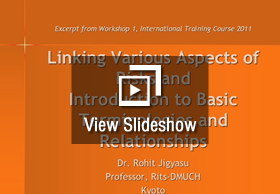


The section introduces the following issues in a broad manner, setting the context for the rest of the course. This section may be combined with the next section (Understanding Key Terminologies) and the previous sections (Cultural Heritage and the Urban Environment) in one session depending on time constraints.
This section introduces participants to the type of disasters and their impact on cultural heritage. Recent disasters and their consequent impact to cultural heritage may be highlighted graphically, using iconic images and also statistical data to impress upon participants the need for disaster risk management. A lecture could be supported by a series of rapid-fire slide shows resulting in an active dialogue between the participants and course coordinators. This section could also provide an opportunity for participants to introduce their own experiences and for the instructor to introduce primary or secondary case studies.
Lecture 1, International Training Course 2012
Instructor: Prof. Kenzo Toki


An excerpt from Significance of Disaster Risk Management and Core Principles
Lecture 3, International Training Course, 2012
Instructor: Rohit Jigyasu


Instructor: Prof. Kenzo Toki, Director, R-DMUCH
Duration: 60 minutes
This session highlighted issues related to protection of cultural heritage from post-earthquake risks, focusing on the case of rich urban cultural heritage of Kyoto. Through this session, using the example of the Kobe Earthquake (1995), and the history of Kyoto’s cultural heritage being damaged due to fire, the following issues were highlighted:
1. Vulnerability of Kyoto in a post-earthquake fire
2. vulnerability of the fire-protection systems and fire extinguishing systems in the event of an earthquake, particularly in historic buildings such as old temples and shrines
3. High density of the significant heritage structures and objects within Kyoto coinciding with the seismic faults
4. Imminence of an earthquake occurring in the near future
Historically, Kyoto ‘s heritage had been at risk, primarily due to political issues and socio-economic causes with a significant proportion of the temples being destroyed in the mind-fifteenth century. However, the situation has changed dramatically over the past century and the greatest threat to the cultural heritage of Kyoto is the occurrence of an in-land earthquake or fire. The evolution of the urban structure of Kyoto is also responsible for dramatically increasing the risks, due to the increased density of urbanisation surrounding the cultural heritage of the city.
The issues with existing fire protection and extinguishing systems in the historic temples or shrines of Kyoto are that they deal primarily with the possibility of a fire occurring inside the structure itself. However, in the event of an earthquake, the possibility of a fire attacking the structure from the outside increasing significantly. Therefore, it becomes imperative to address this possibility as well. Historical sources indicate that a fire in 1788, referred to as the ‘Big Fire’ of Ten’mei was responsible for widespread damage to the timber shrines and temples in the area. Today, this region is devoid of any nationally significant structure or object, and it is fortunate that structures outside the periphery of this zone survived. The key objective now is to recognise that it is unlikely to reconstruct these pieces of heritage, should they be destroyed and therefore it is all the more important to have protective measures and countermeasures in place for their continued protection.
A large active fault known as the Hanaore Fault runs through the Kyoto basin, which is subject to very high seismic forces. Besides this active fault, there are several other active faults. The cultural heritage of Kyoto is concentrated on two different geographical configurations. The first is the hill side and the second, flat land. The Kyoto basin is connected to a large lake, Lake Biwa through 2 canals, which provide the city with a large amount of water. The canal’s water may be used during an emergency to create a water curtain around the structure. The feasibility of such systems needs to be examined carefully as they may not be applicable at all site locations. This system is an adaptation of a system used in the nineteenth century in the Higanshi Honganji temple, located near the canal. The water supply system still exists and may be updated.
Similar case studies have been undertaken for implementing this particular system, such as in the case of the Kiyomizu Temple and near-by community. The plans have been made and implemented in the area as a five years programme of the central and local governments. In cases where the structures will be unable to withstand high pressures of water streams, misting systems are being designed. It should be reiterated that establishing countermeasures for protection of cultural assets in cities and districts such as Kyoto and Nara should be given the highest priority considering the possibility an earthquake occurrence in the future and the vulnerability of these areas for post- earthquake fires.
The lecturer emphasised that experts working on conservation of cultural assets and those working on disaster risk management have begun to collaborate on these issues, which is imperative for the long term future of these sites.